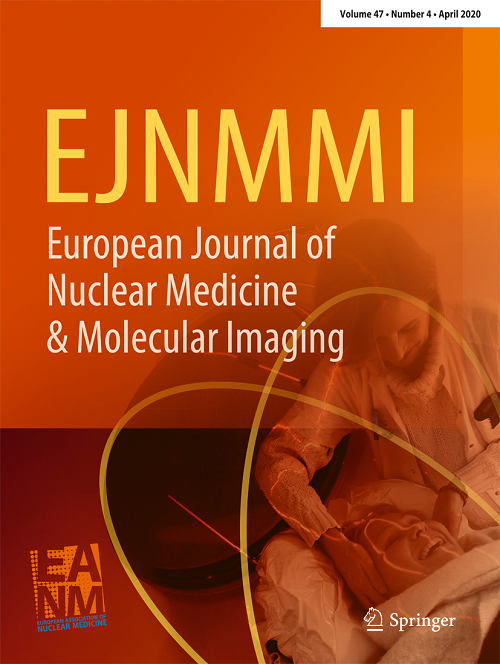Association of metabolic tumour volume (MTV) and total lesion glycolysis (TLG) with survival in patients with oligometastatic non-small-cell lung cancer treated with immunotherapy: a multicentre retrospective study.
IF 7.6
1区 医学
Q1 RADIOLOGY, NUCLEAR MEDICINE & MEDICAL IMAGING
European Journal of Nuclear Medicine and Molecular Imaging
Pub Date : 2025-10-10
DOI:10.1007/s00259-025-07557-9
引用次数: 0
Abstract
PURPOSE Current guidelines recommend adding local radical therapy (LRT) to systemic treatment in synchronous oligometastatic non-small-cell lung cancer (sOM-NSCLC), but survival data on immunotherapy-based regimens are limited. Metabolic tumor volume (MTV) and total lesion glycolysis (TLG) are prognostic in NSCLC, with higher values linked to worse outcomes. This study examines their association with survival in sOM-NSCLC patients treated with immunotherapy. METHODS We conducted a multicenter retrospective study including all consecutive patients with [18F]FDG-PET and brain imaging-staged sOM-NSCLC, between 2015 and 2022, who received first-line (chemo)-immunotherapy and had baseline PET-scan available for review. Subgroups were analyzed based on median MTV and TLG values (high vs. low: H-MTV vs. L-MTV, H-TLG vs. L-TLG). Study endpoints were progression-free survival (PFS) and overall survival (OS), according to MTV and TLG distribution (high vs. low), in the overall population (primary endpoint) and in relation to LRT and systemic treatment type (secondary endpoints). RESULTS 105 patients were included, 50% were male and 73% had non-squamous histology, median age was 64.9 years. Median PFS was significantly longer for L-MTV vs. H-MTV (14.73 months (95%CI, 7.06-22.40) vs. 7.63 months (95%CI, 5.73-9.52), p = 0.028), but also LRT was associated with PFS (19.04 months (95%CI, 8.47-29.60) versus 7.46 months (95%CI, 5.25-9.67), p = 0.045), while neither MTV nor TLG had impact on OS. In multivariate analysis, only PD-L1 < 50% and soft tissue metastases remained significantly associated with shorter PFS. CONCLUSIONS Baseline MTV is preliminarily associated with PFS in sOM-NSCLC patients treated with immunotherapy, but results are exploratory and need prospective validation in larger cohorts.经免疫治疗的少转移性非小细胞肺癌患者的代谢肿瘤体积(MTV)和病灶总糖酵解(TLG)与生存率的关系:一项多中心回顾性研究
目前的指南建议在同步少转移性非小细胞肺癌(sOM-NSCLC)的全身治疗中加入局部根治性治疗(LRT),但基于免疫治疗的方案的生存数据有限。代谢肿瘤体积(MTV)和总病灶糖酵解(TLG)是非小细胞肺癌的预后指标,其值越高,预后越差。本研究探讨了它们与接受免疫治疗的sOM-NSCLC患者生存率的关系。方法我们进行了一项多中心回顾性研究,纳入了2015年至2022年间所有连续接受FDG-PET和脑成像分期sOM-NSCLC的患者,这些患者接受了一线(化疗)免疫治疗,并有基线pet扫描可用于回顾。亚组根据MTV和TLG的中位数值(高与低:H-MTV与L-MTV, H-TLG与L-TLG)进行分析。研究终点是无进展生存期(PFS)和总生存期(OS),根据MTV和TLG分布(高vs低),在总体人群中(主要终点),与LRT和全身治疗类型相关(次要终点)。结果纳入105例患者,男性占50%,非鳞状组织73%,中位年龄64.9岁。L-MTV比H-MTV的中位PFS明显更长(14.73个月(95%CI, 7.06-22.40)比7.63个月(95%CI, 5.73-9.52), p = 0.028), LRT也与PFS相关(19.04个月(95%CI, 8.47-29.60)比7.46个月(95%CI, 5.25-9.67), p = 0.045),而MTV和TLG对OS均无影响。在多变量分析中,只有PD-L1 < 50%和软组织转移仍然与较短的PFS显著相关。在接受免疫治疗的sOM-NSCLC患者中,基线MTV与PFS初步相关,但结果是探索性的,需要在更大的队列中进行前瞻性验证。
本文章由计算机程序翻译,如有差异,请以英文原文为准。
求助全文
约1分钟内获得全文
求助全文
来源期刊
CiteScore
15.60
自引率
9.90%
发文量
392
审稿时长
3 months
期刊介绍:
The European Journal of Nuclear Medicine and Molecular Imaging serves as a platform for the exchange of clinical and scientific information within nuclear medicine and related professions. It welcomes international submissions from professionals involved in the functional, metabolic, and molecular investigation of diseases. The journal's coverage spans physics, dosimetry, radiation biology, radiochemistry, and pharmacy, providing high-quality peer review by experts in the field. Known for highly cited and downloaded articles, it ensures global visibility for research work and is part of the EJNMMI journal family.

 求助内容:
求助内容: 应助结果提醒方式:
应助结果提醒方式:


